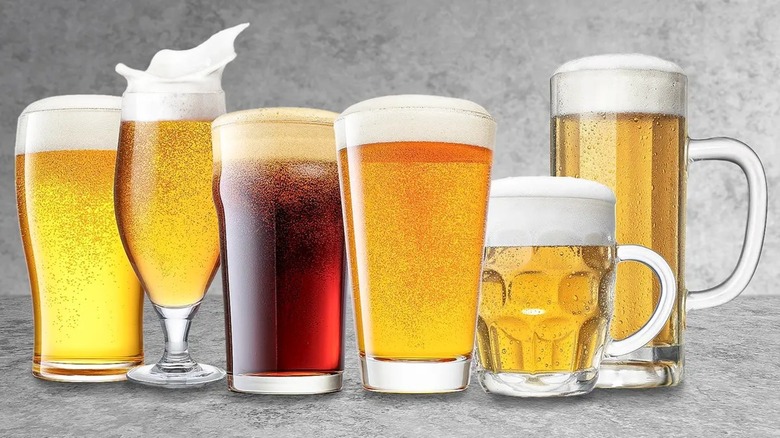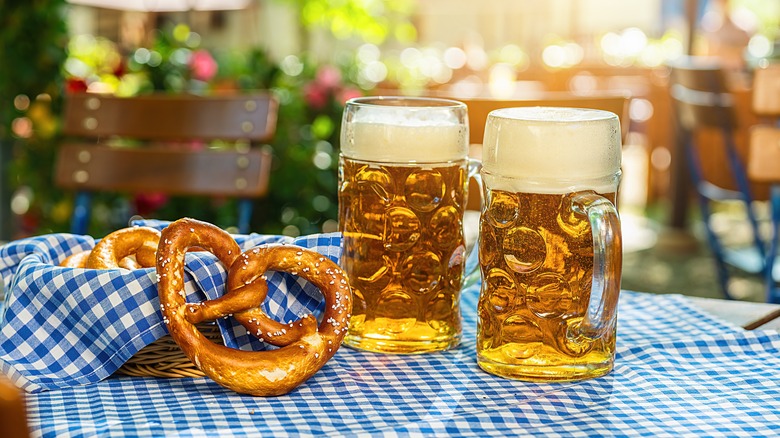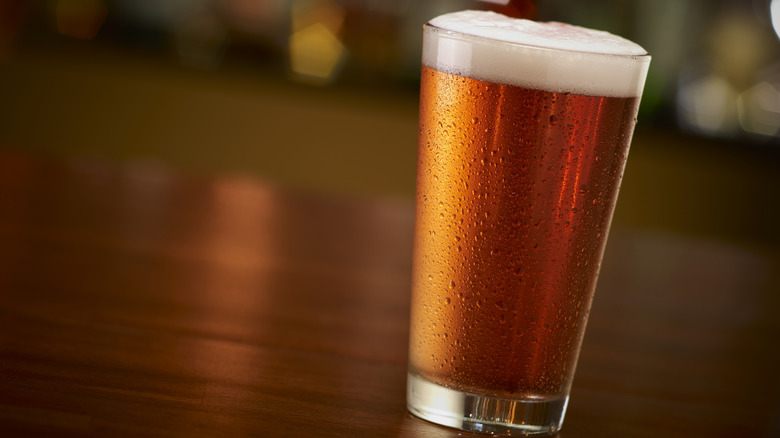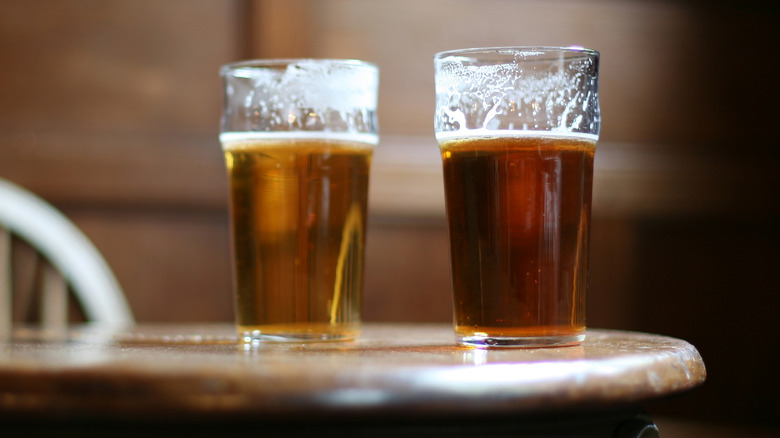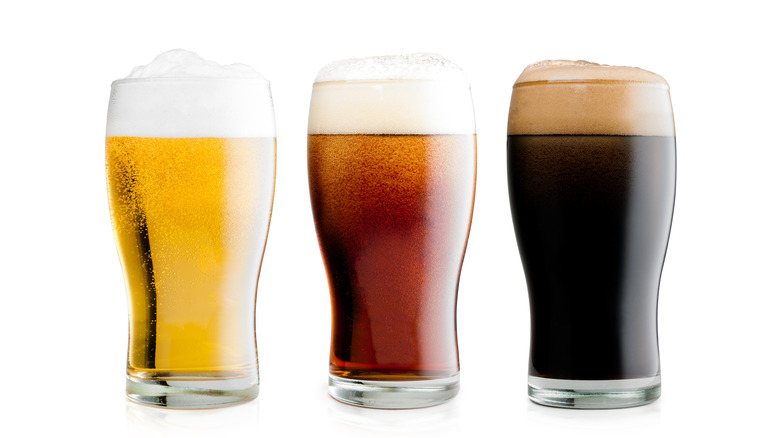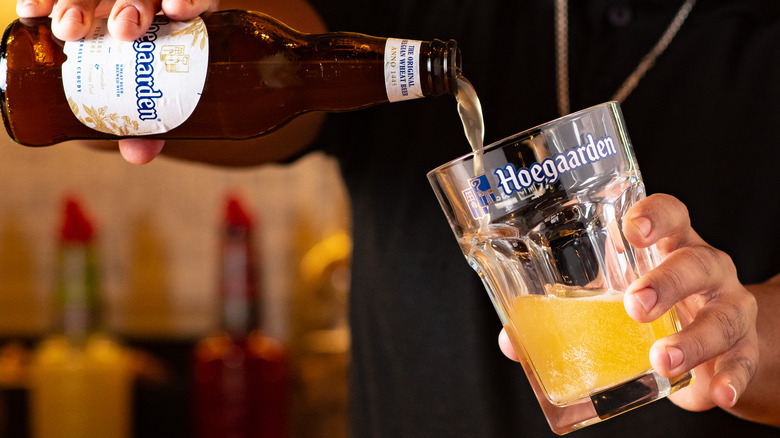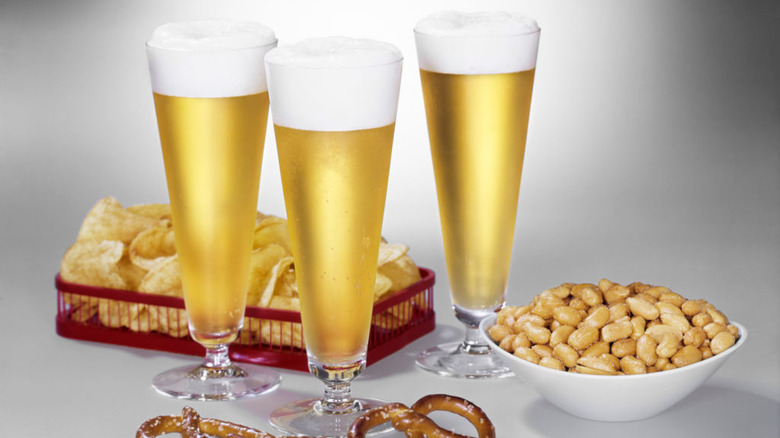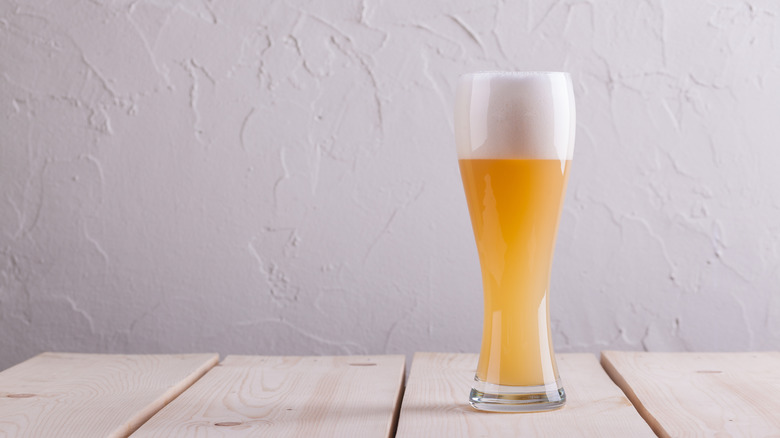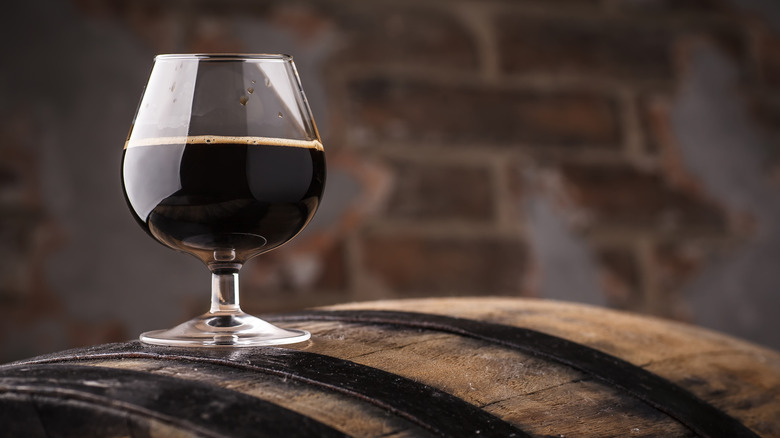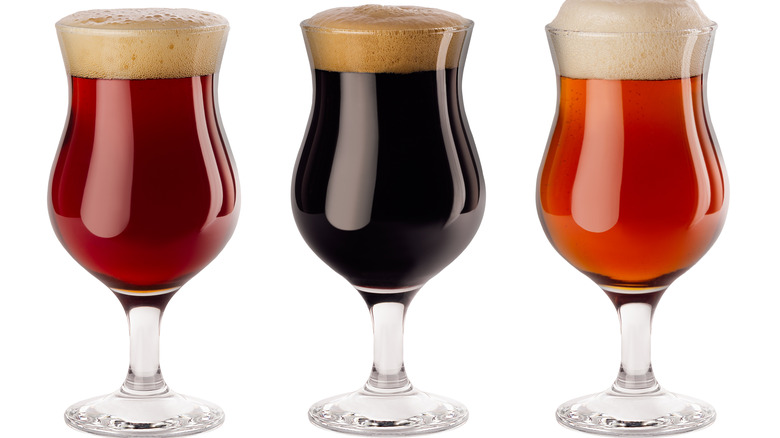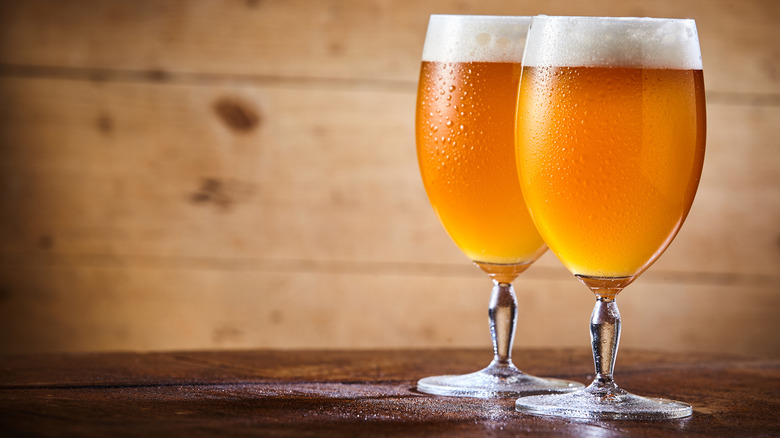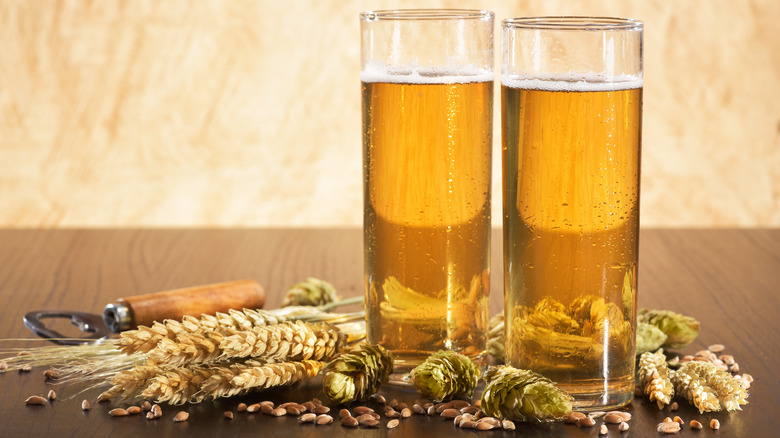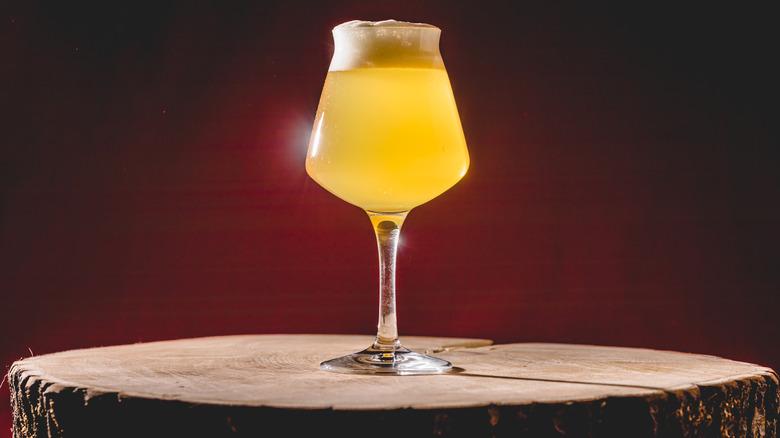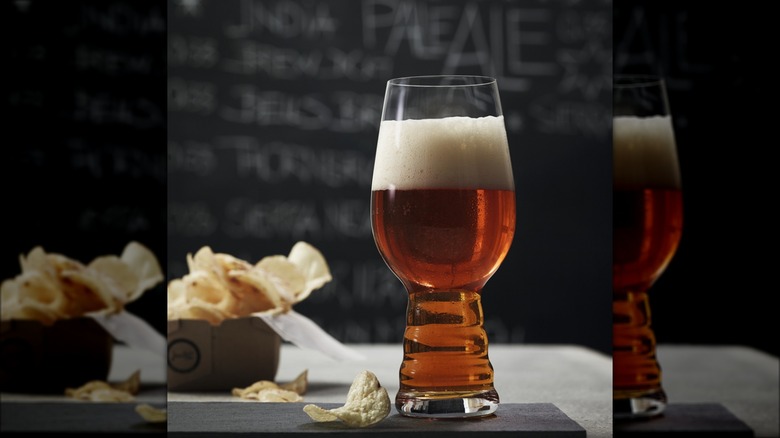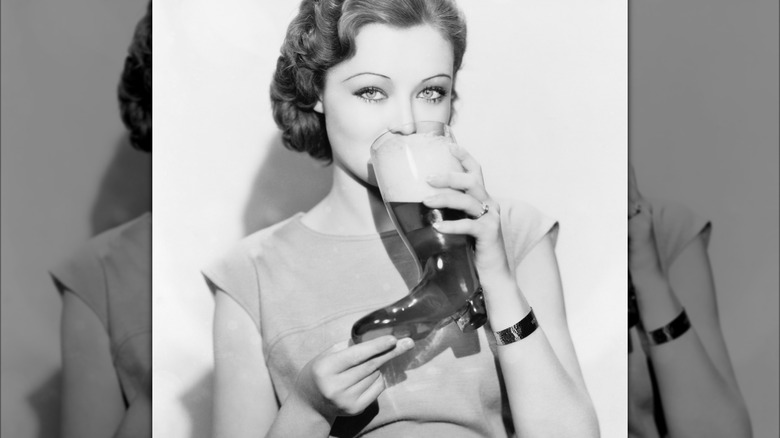14 Types Of Beer Glasses, Explained
It's safe to say that humanity has had a love affair with beer for a long time. And when we say long, we're talking thousands of years. Ancient China, Egypt, and Neolithic Europe? They were all sipping the suds. Heck, the Ancient Sumerians even had a goddess, Ninkasi, solely devoted to beer and brewing. And modern humanity isn't showing any signs of slowing down. More beer is consumed today than any other alcoholic beverage in the world. In the U.S., total consumption is only behind water, coffee, and soft drinks for all beverages. That's a lot of beer.
A few things have changed though. Where once we guzzled simple ale out of goat skins and clay pots, there are now over 100 different styles of beer, with specialty glassware to boot, sometimes literally. Now sure, you can crack open a cold one straight from the bottle, but if you want the full experience — the flavors, the aromas, the craftsmanship — you're going to need the right glass. Proper glassware can mask bitterness, open up flavor, and even lessen bloating due to the way carbonation is dispersed. So if you don't know your snifters from your tulips, or which is the best glass for craft beer, you've come to the right place. Here's a list of 14 types of beer glasses, and what to pour into them.
Steins, tankards, and mugs
Every time you hoist a mug, stein, or a tankard filled with ale, it's like taking a hop, skip, and a jump back to the good ol' days of humanity's beer-infused past. With beer vessel tech having progressed past animal skins and into the realm of clay pots, the addition of a handle really upped the game, allowing raucous toasts and helping beer stay a bit colder. Originally humble water carriers made of wood, stone, or pewter, these vessels upgraded their jobs and became the OG beer-drinking paraphernalia around the 14th century. Today, they are typically made out of glass or ceramic but often still carry intricate designs as nods to their heritage. Oh, and those hinged lids you see on some vintage stein models? Yeah, those are residual from the days of the Bubonic plague.
But enough with the history lesson. Let's not forget that sloshing around a heavy mug of your favorite ale, stout, or lager is just plain fun. Be they of sensible size, or the kind that's larger than your head, they practically beg to be clinked together with friends. No wonder they came out on top in our poll of favorite beer glasses. Prost!
Shaker pint
Bar patrons know the classic shaker pint, sometimes called the American pint, as the ubiquitous hero of beer joints and casual gatherings. Holding up to 16 ounces and originally designed for mixing cocktails, the shaker pint, with its tapered, conical shape, has found its way into the hands of beer enthusiasts worldwide, for better or worse. The shaker pint is a true jack-of-all-trades, with its simplicity earning both cheers and jeers. On the plus side, it's fantastic for flaunting the vibrant hues and bubbles of pale ales and lagers. Its wide opening makes sipping a breeze, too. However, not everyone's a fan. Critics argue that the broad surface area up top can dull the aroma and diminish the head retention of more complex brews. Moreover, its shape encourages you to hold it in your palm, which might cause your beer to warm up more quickly than you like.
Despite its imperfections, the shaker pint is a multi-tasker, and though it won't make them shine, it can handle many different kinds of brews. Plus, it's an improvement from sipping straight from the bottle or can. Just a heads up: These stackable glasses come with a caveat, so handle them with care, for they've been known to shatter when stacked.
Nonic pint
In the 1960s, this distinctive and functional cousin to the shaker pint was popularized in the British pub scene. The nonic (pronounced "no-nick") pint glass, also known as a British pint glass, boasts a unique feature — a pronounced bulge near the rim that is more than simply for looks. Created for use in bustling pubs, the curve helps the drip of both bartenders and patrons and facilitates easier stacking without the risk of sticking or shattering. What's more, in the inevitable event that a glass topples over, the bulge takes the brunt of the impact, sparing the more delicate rim from getting chipped or nicked (thus, how this glass got its name).
For those of us not working at the local pub, this clever design can also improve aroma and keep the foamy head around a bit longer, helping to ensure your beer isn't flat before you finish it. Coming in American 16-ounce or Imperial 20-ounce varieties, the nonic pint glass is definite step up from the shaker. It's suitable for just about any beer with moderate alcohol by volume (ABV), but is ideal for British-style ales, IPAs, and lagers.
Tulip pint
The tulip pint, a familiar friend to Guinness aficionados worldwide, is more than just a vessel; it's a piece of the legendary Guinness experience. Its iconic shape, coupled with the meticulous 6-step pour (complete with the infamous and excruciating 119.5-second wait for the beer to settle), has played a pivotal role in catapulting Guinness to its status as the most-renowned stout globally.
These are sometimes referred to as Irish or Imperial pints, though Imperial technically refers to the glass's 16-ounce volume rather than its style. You'll find a large amount of British and Irish breweries offering up branded iterations of the tulip pint. And no wonder, as this pint has more tricks up its sleeve than you might think. The outward bulge and inward flare at the top are no mere design quirks; they work together to concentrate and funnel the rich aromas of all sorts of aromatic and complex brews. While it's the go-to for stouts and porters, the tulip pint's captivating curvature and eye-catching appearance make it a versatile choice for an array of beer styles — from cream ales to brown ales and even the hoppy world of IPAs. Stay away from the high ABV stuff though, as this is a glass meant for taking large gulps.
Belgian hex glass
This quirky hexagonal glass has roots that trace back to the year 1445, when the story of the iconic Hoegaarden brewery began. Hoegaarden was, and is, a quaint Belgian village in the region of Flanders, famed for its witbiers — hazy and refreshing brews that blend wheat along with orange peel and spices, such as coriander. In those days, farmers crafted this elixir and reportedly sipped it from whatever was on hand, often recycled jars that once held jams and preserves.
From those humble beginnings came this hexagonal glass, a tribute to those jam jar roots. The light refraction caused by the glass's angled sides highlights the sunny yellow of witbiers and other wheat ales. It's also been claimed that this unique shape not only pays homage to the beer's rustic past but also serves a practical purpose: Ensuring the brew remains cool. But let's be real, we like it because it looks cool.
Pilsner glass
Dialing up the aesthetics quite a bit is the pilsner glass, a slender and tapered vessel designed to showcase the effervescence and clarity of the most popular style of beer worldwide, the beloved pilsner. Pilsners came to be in 1842 in the city of Plzen (Pilsen in German and English) in what is now the Czech Republic. In a world of muddy-looking ales and lagers, the pilsner's clarity and stunning straw color shone like a beacon. Naturally, it needed a glass to showcase this marvel. With the Industrial Revolution making glass production more cost-effective, there was finally a beer worthy of being shown off.
Typically holding 10 to 15 ounces, the narrow shape of the pilsner glass allows the golden hues and lively bubbles of the pilsner beer to dance, creating a visual spectacle that enhances the overall beer-drinking experience. Beyond its visual appeal, the pilsner glass's tapered walls maintain the beer's carbonation, ensuring a consistently effervescent sip from start to finish. It's ideal for lighter beer styles, including both the classic Czech pilsner and the hop-forward German variety.
Weizen glass
This beauty is sometimes confused with the pilsner glass, as both are tall, slender, and eye-catching vessels. There are quite a few differences, however, and not just in the aesthetic department. For starters, the weizen glass boasts a larger and curvier build, with thicker walls than the pilsner, a design specifically for hefeweizens and other wheat-based brews. This elongated shape allows the beer to breathe, releasing the intense banana and clove aromas characteristic of wheat ales. In addition, the generous size and the bulbous top of the glass are designed to accommodate and contain the dense fluffy head, ensuring each sip is flavorful and aromatic.
As a bonus, the waist-like curvature leading from the narrow base to the swell near the top of the weizen glass acts as a trap for the signature hefeweizen yeast, keeping it from your lips as you sip. It's a perfect glass for enjoying the fruity and spicy notes of hefeweizen, its darker sibling dunkelweizen, and American wheat beers.
Snifter glass
For a more refined beer experience, maybe at a fancy restaurant or for a special get-together, raise your pinky and reach for a snifter. It's a vessel crafted for the connoisseur seeking to capture the intensity of aromas in strong and complex brews. The wide bowl and narrow top of the snifter encourage a gentle swirl, unlocking the nuanced scents of big beers — think barleywines, imperial stouts, and barrel-aged creations. A symbol of sophistication, this glass elevates the tasting experience, revealing the hidden depths within each sip.
The shape encourages you to hold the glass in your palm, providing a warming effect to your beer that not only enhances those aromas but brings hidden complexities to the forefront of higher-alcohol content beers. Whether you're savoring the complexities of an aged beer from the cellar or exploring the bold flavors of a Trappist ale, the beer snifter becomes an essential companion for those who appreciate the finer nuances of craft brewing.
Tulip glass
The tulip glass is truly a darling of the craft beer scene, and variations can be found at tasting rooms around the world. Named after the flower that inspired its shape, it's a vessel designed to highlight the intricate aromas and flavors of complex brews. The curved bowl and narrowed top of the tulip glass create a sensory experience, concentrating the rich scents of stronger ales, IPAs, and stouts, but also allowing more subtle notes in blondes, sours, and fruit beers to shine.
It's not too shabby in the looks department either, showcasing the rich hues of ales and lagers. Finally, the stem allows the beer to be held in a variety of ways. For a more complex ale, letting the beer warm in your hands will bring out new and exciting flavors and aromas. Enjoying a lighter beer? Hold it by the base so your brew stays frosty.
Goblets and chalices
Goblets and chalices tend to conjure up medieval imagery — think massive feasts with jeweled golden cups drunk by kings — or religious ceremonies with holy symbols and people in robes. Is it any wonder, then, that the beers most commonly associated with these vessels are themselves relics of an earlier era? Belgian dubbels, tripels, and quads, as well French style ales like Bière-de-Garde, in particular, benefit from the wide, deep bowl of this design. In fact, many Trappist breweries, in which ales are brewed by cloistered monks from an order dating back to the 1600s, make specific versions of goblets or chalices that correspond to the beer they make, sometimes with etchings and decorations that speak to their rich history.
These majestic vessels don't just work for ale of the European variety, however. Any beer that is higher in alcohol, be it an Imperial stout, a double IPA, or a craft beer brewed in the Belgian style, will benefit from being served in one of these. Not only will they highlight their complexity, but they'll also make it a bit feel a bit like more of an "occasion" when you pop one.
Stange glass
The German people traditionally take their beer very seriously. So seriously, in fact, that they have a group of regulations on beer production that date back to the year 1516. Collectively known as "Reinheitsgebot," these laws specifically state what you can and can't put into German beer. Unsurprisingly, over 500 years of adherence to these restrictions have led to Germany being practically synonymous with good, simple, classic beer. Precision, rather than gimmick, is the name of the game here. It's no wonder then that the glass known as the stange — meaning "rod" or "stick" in German – or the tube hails from the Rhineland, as well. Simple, sleek, and slender, it's a vessel designed to showcase the clarity and effervescence of delicate beer styles. The stange glass is characterized by its straight, narrow shape, allowing you to fully appreciate the color and carbonation of pale lagers and Kölsch, a pale ale that hails from Cologne, Germany.
Now, you may be wondering about the lack of a stem. Won't that make the beer get warm too quickly? Nein. These glasses typically carry less than 7 ounces of volume, so you're bound to finish before it loses its freshness. What's more, in traditional Kölsch service, once you order your first beer, your server (or köbes) will continue to put a fresh glass next to the one you're about to finish, ensuring you always have a fresh brew at the ready.
Teku glass
Brace yourself, we're about to get a lot more modern. Since its introduction to the beer world in 2006, cicerones and brewers alike agree that there's nothing quite like the Teku glass from Rastal — a sophisticated 14.2-ounce vessel meticulously crafted to elevate the tasting experience for a wide range of beer styles. Sitting somewhere near the junction where tulips and chalices meet, the Teku glass is specifically designed with craft beer in mind, combining elegance with functionality. Its tulip-shaped bowl and flared lip enhance aromas, open up flavors, and maintain temp and head while its aesthetics are still head-turning.
Born from a collaboration between Teo Musso, an Italian craft brewer, and Lorenzo "Kuaska" Dabove, a renowned beer expert, the Teku glass is quite the versatile companion for beer enthusiasts. It does it all — and looks good doing it. Whether you're craving a light and fresh lager, a brisk sour, or something dark and broody like a barrel-aged stout, the Teku has you covered. It's a beer geek's best friend.
IPA glass
As the craft beer movement began moving toward bolder IPAs, a need arose for a glass to properly highlight the grassy, resiny, or tropical goodness of these creations. The Spiegelau IPA glass answered the call in 2013 with a creation that utilized the hop expertise of Sam Calagione of Dogfish Head and Ken Grossman of Sierra Nevada, aka two titans of the IPA scene.
They seem to have thought of everything. The 19-ounce glass features a ridged base that aerates the beer with every sip, leading to a narrow waist and a flared lip. The tulip-like design concentrates the aromas of the hops, the wide bowl provides ample space for the beer to breathe, and the thin rim ensures a crisp delivery allowing aficionados to fully appreciate the vibrant citrus, pine, and floral notes of their favorite IPAs. To top it off, so to speak, these glasses have laser etching on the bottom that keeps the flow of carbonation coming, adding to the heady spectacle and fostering the fragrant aromas. Whether enjoying a bold resiny West Coast IPA, a juicy New Englander, or a refreshing session, the IPA glass is a hophead's ticket to paradise.
The beer boot
Like your beer with a healthy dose of camaraderie and a touch of mischief? Check out Das Boot – or bierstiefel, as it's known in German. This iconic vessel, shaped like a tall boot, is a symbol of conviviality and shared celebrations. Whether you're enjoying a hearty lager or a refreshing pilsner, the contents of the beer boot are meant to be downed quickly, adding an element of fun to the beer-drinking experience. Depending on the angle you start with, air may begin to move down the length of the boot towards the toe. Once at the toe, the beer can tend to glug out uncontrollably, usually leading to a face full of suds. Some say the challenge lies in mastering the tilt and timing of the 90-degree turn necessary to avoid the infamous beer shower, but true boot masters know that beginning with the boot positioned toe-side down will give you a steady pour.
Though a few different origin stories exist, one favorite legend has it that a 19th-century Prussian general, seeing that his troops were hopelessly outmatched, offered to drink beer from his boot should his army prove victorious. And wouldn't you know? The day was his, he opted for a custom-made glass boot, and a tradition was born. The practice fell slightly out of favor in the modern era until it was revitalized by the 2006 movie "Beerfest," and it has now regained its place as a favorite at festive gatherings worldwide.
